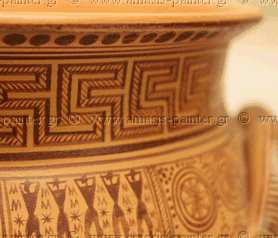Hellenic Pottery Painting
in Historical Times
|
Special reference should be made to the white Attic lekythoi of the classical era and their style. The intention of the painter is depicted with simple and often hasty strokes on a white background. Special attention is paid to eyes, movement of the body and body-build.
During this period (Peloponnesian War), the white lekythos is mainly used in funerary situations. The coldness of the grave white strongly depicts the pathos and the eerie atmosphere around the grave. The images on lekythoi some times present the introversion of personal contemplation and some other times the wish for contact between the dead and the living since meeting each other is impossible. The impossibility of contacting each other is accomplished through the eyes, through their divergence or convergence to a point, a situation which signifies a communion or a bond but in another place and time in the past. These images also depict the hidden sorrow of farewell or the bitterness for the untimely loss of a young man who, having been raised with the ideals of the golden era, left one day to participate in a war, bearing the arms given to him by his own people. People, he would never see again but in his mind. This is probably the apex of vessel painting, the ultimate completion of sentimental depiction.
Vessel painting in Attica starts to decline after the Peloponnesian war. There are, however, some efforts with new multi-coloured images but without success. What was to be presented had already been depicted in a fine and admirable manner by the early 4th century BC.
Katsaras Thanasis sociologist, potter-vase painter
This text was written in April 1990 and was used as a guide for the vessel exhibition which took place at the community centre of the Municipality of Eleusis. It was also published in the magazine “Πόσιμον Ύδωρ”….
![]()
HAND MADE AND PAINTED IN GREECE






